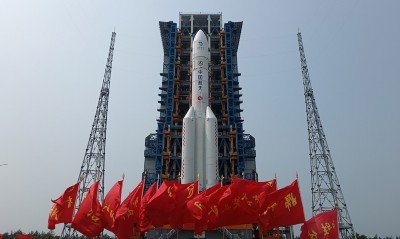China’s Chang’e-6 robotic Moon-lander has wrapped up two days of drilling into the surface of the far side of the Moon and the ascender has blasted back into space. The spacecraft, with its precious rock samples, is now in lunar orbit, waiting to dock with the orbiter for the trip back home. It is the first time samples have been taken from the far side of the Moon.
The Chang’e-6 lander made a successful touch-down on the Moon early on Sunday morning (Beijing time) at a pre-selected site within the South Pole-Aitken (SPA) basin, the oldest and largest lunar impact basin. Since then, Chang’e-6 has autonomously deployed its drill and scoop to collect soil and lunar regolith — the rocky material covering the surface of the Moon. Together the samples are expected to weigh up to two kilograms. “The sampling process has gone very smoothly,” says Chunlai Li, the mission’s deputy chief designer at the National Astronomical Observatories in Beijing.
With the specimens loaded and sealed, the ascender fired its engine at 7:38 am Tuesday morning to lift off from the landing site and reached the designated lunar orbit six minutes later, according to the China National Space Administration (CNSA).
“China is successfully carrying out complex operations on the lunar far side,” says Jonathan McDowell, an astronomer at the Harvard-Smithsonian Center for Astrophysics in Cambridge, Massachusetts. “The launch of the ascent stage was the first time anyone has taken off from the far side.”
Captivating basalt
According to Li, Chang’e-6 precise landing location is 41.63 degrees south and 153.99 degrees west, which means that the samples will mainly consist of basalts — dark-coloured, cooled lava. Similar material has previously been brought back to Earth for analysis from the Moon’s near side.
The age of the basalts is estimated to be around 2.4 billion years old—much younger than the SPA basin itself, says planetary geologist Alfred McEwen at the University of Arizona, Tuscon. “There should also be fragments of older rocks in the regolith they collected,” McEwen says.
What China’s mission to collect rocks from the Moon’s far side could reveal
Scientists hope to use samples returned from the SPA to precisely measure the basin’s age, and improve their understanding of the early history of the Earth and other planets, notes planetary geologist Jim Head at Brown University, in Providence, Rhode Island.
Regardless of whether this information can be gleaned from the samples, the scientific value of Chang’e-6 samples, if successfully returned, will be very high, he says. They will be the first rocks ever retrieved from the Moon’s far side, which is dramatically different from the near side. “Obtaining dates and compositional information from the many hundreds of fragments sampled by the Chang’e-6 drill and scoop is like a having treasure chest full of critical parts of lunar history, and will very likely revolutionize our view of the entire Moon,” he says.
Rock then dock
In the coming days, Chang’e-6 will face one of the trickiest parts of the whole mission — rendezvous and docking of the ascender with the orbiter and transferring the samples, says McDowell. “You have two robots orbiting the Moon separately at 5,900 kilometres per hour, which have to come together and touch each other gently without crashing into each other,” he says.
The Chang’e-6 samples’ trip home is expected to last about three weeks, ending with a return capsule piercing through Earth’s atmosphere and landing in the grasslands of the Siziwang banner in northern China’s Inner Mongolia autonomous region around 25 June.
Planetary scientist Michel Blanc at the Research Institute in Astrophysics and Planetology, in Toulouse, France, who watched the launch of Chang’e-6 on Hainan island a month ago and followed the key steps of the mission, says that the scientific impact of the mission cannot be over-emphasized, because it will not only bring the first sample from the lunar far side, but also from one of the lowest-altitude regions of the Moon, where the surface might be closest to the mantle.
“We planetary scientists are crossing fingers for the success of the rest of the mission,” Blanc says.




